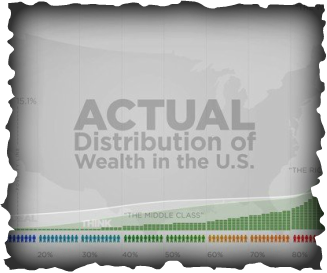 An illustration of economic inequality in the United States Tags: capitalism, class, economic sociology, inequality, knowledge, class analysis, ideology, wealth, 06 to 10 mins Year: 2012 Length: 6:24 Access: YouTube Summary: With an impressive suite of illustrations, this viral video takes viewers through the findings of a 2011 study conducted by Dan Ariely and Michael Norton, who asked respondents two basic questions. First, they asked people to report what they thought the ideal distribution of wealth in the United States should be, then they asked them how they thought wealth was actually distributed. The results suggest that, on average, Americans believe economic inequality is greater than what is ideal—i.e., the wealth gap is too large. The researchers then presented the actual distribution of wealth in the United States and compared it with both the ideal distribution and respondents' estimate of the actual distribution, and based on this comparison, it seems reasonably clear that while Americans may believe the wealth gap is too large, they are tragically misinformed about just how large it actually is. How is it that Americans are unaware of the magnitude of this inequality? Ariely and Norton do not provide an answer, but the question is worth pursuing. Consider the fact that publics have long proven a capacity to know about a wide range of phenomena that is effectively invisible. For instance, most people in the United States know about the dwarf planet Pluto, despite never seeing it with their own eyes. Thanks in large part to the mainstream media and the reverberations of social media, people in New Mexico and Montana know about the recent Boston Marathon bombings and can even recount vivid details about the event, even if they have never been to Boston and have no intention of ever visiting. But unlike Pluto and the tragedies of distant cities, the telltale signs of inequality are everywhere. In Boston, New Mexico, Montana, and virtually every other point on the map, one can find poverty within a few miles or blocks of obscene wealth; yet the true magnitude of U.S. inequality eludes most Americans. This video is not merely useful for wrapping one's head around the extent of inequality in the United States—that the top 1% holds 40% of the nation's wealth—it is also a useful segue into a discussion that connects the material facts of economic inequality to the ideological forces that ensure it remains uninterrogated. Explaining how a system of economic inequality persists requires more than simply identifying the disparities; it also requires an explanation about how publics remain relatively unaware of these disparities. For a similar analysis in a PBS clip, see here. Submitted By: Lester Andrist
3 Comments
hlam
1/22/2014 11:15:28 pm
I am by no means criticizing the message of the post, but breaking the text into paragraphs would make the information a lot easier to digest. I want to share these pages, but I find that large blocks of text often end up scaring people off.
Reply
Manuel Franco
7/29/2023 02:59:17 am
I just want to say Thank You to everyone who supported me through the years. My name is Manuel Franco, New Berlin, Wisconsin. My story of how I won the Powerball lottery of $768.4M is a bit of a tale. I have been playing Powerball tickets for 6 years now since I turned 18. I bought my first ticket on my 18 birthday. I was feeling very lucky that day because I had contacted Dr. Odunga Michael to help me with the winning Powerball numbers. I really had that great great feeling that I looked at the camera wanting to wink at it. I only did a tiny part of it and trusted him. He gave me the numbers after I played a couple other tickets along with it for $10. I checked my ticket after the winnings came online and saw the numbers were correct including the Power play. I screamed for about 10 minutes because it felt like a dream. I had won $768.4M. You can check my winning testimony with the lottery officials just with my name search. Thank you Dr Odunga. Well, his email is [email protected] and you can also call or Whats-app him at +2348167159012 so you guys can contact him
Reply
mark hold
7/8/2024 12:30:14 am
Herbal Penis Enlargement product is 100% guaranteed to Enlarge and get a better ERECTION, the reason why most people are finding it difficult to enlarge Penis is that they believe in medical reports, drugs and medical treatment which is not helpful for Penis Enlargement. Natural roots/herbs are the best remedies which can easily Enlarge your Penis permanently Contact Dr MOSES BUBA via Email: [email protected] or via WhatsApp: +2349060529305. for Natural root and herbal remedies put together to help Enlarge manhood and Erect healthily. I also learn that Dr MOSES BUBA also can cure other types of diseases, HEPATITIS B,DIABETICS,CANCER,HPV,LOW SPERM CAM, HIV/STDS, FIBROSIS LOST OF WEIGHT, BREAST ENLARGEMENT, HIPS and BUMS ENLARGEMENT etc .
Reply
Leave a Reply. |
Tags
All
.
Got any videos?
Are you finding useful videos for your classes? Do you have good videos you use in your own classes? Please consider submitting your videos here and helping us build our database!
|
 RSS Feed
RSS Feed
